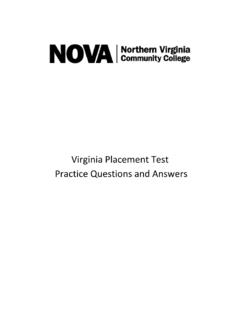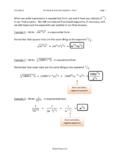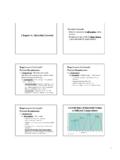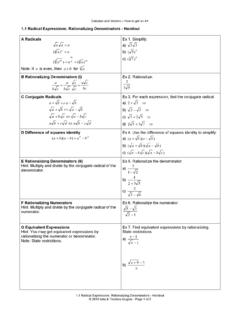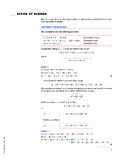Transcription of Florida Department of Education COURSE …
1 2002. Florida Department of Education COURSE DESCRIPTION - GRADES 9-12, ADULT. Subject Area: Mathematics COURSE Number: 1208300. COURSE Title: Liberal Arts Mathematics Credit: Will meet graduation requirements for Mathematics Basic Assumptions for Mathematics Education : All students have access to calculators and computers. Classroom activities are student-centered, emphasizing concrete experiences and active/experiential learning. All courses have increased emphasis on problem solving, estimation, and real-world applications. Evaluation includes alternative methods of assessment. All strands addressed in the Sunshine State Standards are developed across the PreK-12 curriculum. A. Major Concepts/Content. The purpose of this COURSE is to enable students to strengthen algebraic and geometric concepts and skills necessary for further study of mathematics.
2 The content should include, but not be limited to, the following: - exponents and radicals - algebraic expressions and polynomials - equations (linear and quadratic) and inequalities - coordinate geometry - functions, relations, and graphs - systems of linear equations and inequalities - properties of two- and three-dimensional figures - geometric relationships - basic concepts of data analysis and probability COURSE Number: 1208300 - Liberal Arts Mathematics Page 2 of 4. This COURSE shall integrate the Goal 3 Student Performance Standards of the Florida System of School Improvement and Accountability as appropriate to the content and processes of the subject matter. COURSE student performance standards must be adopted by the district, and they must reflect appropriate Sunshine State Standards benchmarks.
3 B. Special Note. This COURSE does not meet the academic core requirement in mathematics for entry into the State University System of Florida or eligibility requirements for some Bright Futures Scholarship options. C. COURSE Requirements. These requirements include, but are not limited to, the benchmarks from the Sunshine State Standards that are most relevant to this COURSE . Benchmarks correlated with a specific COURSE requirement may also be addressed by other COURSE requirements as appropriate. The benchmarks printed in regular type are required for this COURSE . The portions printed in italic type are not required for this COURSE . After successfully completing this COURSE , the student will: 1. Estimate, simplify, and evaluate expressions with radicals and exponents.
4 Understand that numbers can be represented in a variety of equivalent forms, including integers, fractions, decimals, percents, scientific notation, exponents, radicals, absolute value, and logarithms. understand and use the real number system. add, subtract, multiply, and divide real numbers, including square roots and exponents, using appropriate methods of computing, such as mental mathematics, paper and pencil, and calculator. COURSE Number: 1208300 - Liberal Arts Mathematics Page 3 of 4. 2. Demonstrate knowledge of operations on polynomials and simplify algebraic expressions and polynomials. describe, analyze, and generalize relationships, patterns, and functions using words, symbols, variables, tables, and graphs. 3. Demonstrate use of varied methods ( , words, tables, graphs, variable representations) to analyze mathematical concepts in problem-solving situations.
5 Understand concrete and symbolic representations of real and complex numbers in real-world situations. represent and apply geometric properties and relationships to solve real-world and mathematical problems including ratio, proportion, and properties of right triangle trigonometry. 4. Solve linear equations, quadratic equations, and inequalities. determine the impact when changing parameters of given functions. 5. Demonstrate knowledge of coordinate geometry and graphing functions and relations. using a rectangular coordinate system (graph), apply and algebraically verify properties of two- and three- dimensional figures, including distance, midpoint, slope, parallelism, and perpendicularity. 6. Solve systems of equations and inequalities by algebraic and graphic methods.
6 Use systems of equations and inequalities to solve real- world problems graphically, algebraically, and with matrices. COURSE Number: 1208300 - Liberal Arts Mathematics Page 4 of 4. 7. Demonstrate knowledge of the properties of two- and three- dimensional figures ( , polygons, circles, solids) to solve real-world problems. use concrete and graphic models to derive formulas for finding perimeter, area, surface area, circumference, and volume of two- and three-dimensional shapes, including rectangular solids, cylinders, cones, and pyramids. 8. Demonstrate use of transformations and the properties of congruence, similarity, parallelism, and perpendicularity. relate the concepts of measurement to similarity and proportionality in real-world situations.
7 Understand geometric concepts such as perpendicularity, parallelism, tangency, congruency, similarity, reflections, symmetry, and transformations including flips, slides, turns, enlargements, rotations, and fractals. 9. Demonstrate use of basic concepts and techniques in data analysis, introductory statistics, and probability. interpret data that has been collected, organized, and displayed in charts, tables, and plots. calculate measures of central tendency (mean, median, and mode) and dispersion (range, standard deviation, and variance) for complex sets of data and determine the most meaningful measure to describe the data. determine probabilities using counting procedures, tables, tree diagrams, and formulas for permutations and combinations.
8 Design and perform real-world statistical experiments that involve more than one variable, then analyze results and report findings.

